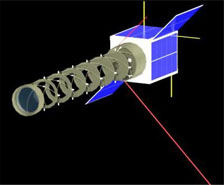
Q. What should be done to enhance space development in Japan?
First, I have the impression that there are few people with a specific passion for making practical use of space, and this has to be changed. In contrast, in the world of space science, for instance, there are many researchers who are very eager to acquire data. That field is flourishing because they are very determined and tend to spend their limited budgets more thoughtfully. It doesn't seem to me, though, that as many people are truly passionate about making use of space. Many people are interested in working in the field simply because that's what NASA is doing.
So first, I think we need to figure out how many people are interested in space, and what specific areas they want to focus on. To do so, we will need to establish more user communities. There are already many communities associated with various technologies, such as the societies for control technology and communication technology. Space science has a very strong user community, but very few user communities exist in other fields of space study. When there is no user community, if a person who has planned and initiated a satellite project has to leave their position because of reorganization, for instance, the objective of the project can be lost. To avoid such a situation, I think that we need to establish a system where missions and projects are led by those who have real zeal for making use of space. Otherwise, money will not be spent wisely. The worst-case scenario is that, on completion of a satellite, there will be no one to use it. And a mission cannot exist without users.
Also, Japanese space development needs a strong vision. In my opinion, a vision should not be about what to adopt, but what to abandon. When you are going to spend a large portion of a budget, you have to make difficult decisions on what to proceed with and what to forego; otherwise ideas with strong potential can be lost without ever being developed and enhanced, due to a lack of focus. And since Japan's space budget is small, there is no use in turning ourselves into a mini-NASA. As long as we are trying to do everything that NASA is doing, but on a smaller scale, we will remain in second or third place. So I believe that Japan should focus on selected projects with the greatest potential for enhancing Japan's global profile in space development.
In this regard, I'm very confident that development of nanosatellites will be one of Japan's key strengths. When people from overseas see the CanSat and the CubeSat, which were made by students, they are always very surprised at how sophisticated they are. The Japanese are very good at stuffing many functions into small objects. Where foreigners compact five functions, the Japanese can do seven or eight. The University of Tokyo and the Tokyo Institute of Technology were the first in the world to launch nanosatellites. And, although other countries have launched their own since then, only four are still working, all produced by the same two universities.
When size is the limiting factor, the Japanese tend to show superb imagination. I am sure there are other technologies that have good potential to become world-class, and I do hope that projects involving such prominent technologies will be undertaken. In addition to continuous support for small-satellite launches, as I mentioned earlier, I look forward to the further refinement of Japan's space-development infrastructure.
Q. Could you tell us about the nanosatellite currently in development?

The nanosatellite PRISM in development(Courtesy of Intelligent Space Systems Laboratory)
|
We're developing PRISM, and aiming to launch by 2008. Our project's original goal was to test whether student-made satellites could really work in space, and also to see whether such a program would be beneficial as an educational tool. And now, we're thinking of making satellites of more utility. The two CubeSat XI satellites, which have already been launched, have on-board cameras, but we're planning to mount a high-resolution camera on PRISM, which will be able to capture images of the ground with 30 m resolution. The satellite will be about 20 cm-cubic, and weigh about 5 kg. We could install a higher-resolution camera if we made a larger satellite, but it would cost us more time and money. Also, more parts mean a higher chance of failure. I think a 10 kg satellite is the maximum size for university laboratories, so we'll see what we can do without crossing that limit.
Apart from the higher resolution, what makes PRISM different from the others is its camera's extendible boom. Telephoto lenses are used to increase resolution, but they influence the size of satellites, so we're developing an extendible boom system, which will be folded at first and stretched to 80 cm in orbit. When this technology is established, as on the Furoshiki satellite, satellites will be compact when launched and deploy fully in orbit. We're very anxious to succeed with this, as the technology is very important for small satellites.
|